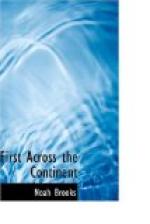“In the evening we killed three deer and four elk, which furnished us once more with a plentiful supply of meat. Shannon, the same man who had been lost for fifteen days (August 28 to Sept. 11, 1804), was sent out this morning to hunt, up the northwest fork. When we decided on returning, Drewyer was directed to go in quest of him, but he returned with information that he had gone several miles up the (Wisdom) river without being able to find Shannon. We now had the trumpet sounded, and fired several guns; but he did not return, and we fear he is again lost.”
This man, although an expert hunter, had an unlucky habit of losing himself in the wilderness, as many another good man has lost himself among the mountains or the great plains. This time, however, he came into camp again, after being lost three days.
On the eighth of August the party reached a point now known by its famous landmark, Beaver Head, a remarkable rocky formation which gives its name to Beaverhead County, Montana. The Indian woman, Sacajawea, recognized the so-called beaver-head, which, she said, was not far from the summer retreat of her countrymen, living on the other side of the mountains. The whole party were now together again, the men with the canoes having come up; and the journal says:—
“Persuaded of the absolute necessity of procuring horses to cross the mountains, it was determined that one of us should proceed in the morning to the head of the river, and penetrate the mountains till he found the Shoshonees or some other nation who can assist us in transporting our baggage, the greater part of which we shall be compelled to leave without the aid of horses.”. . .
Early the next day Captain Lewis took Drewyer, Shields, and M’Neal, and, slinging their knapsacks, they set out with a resolution to meet some nation of Indians before they returned, however long they might be separated from the party.
The party in the canoes continued to ascend the river, which was so crooked that they advanced but four miles in a direct line from their starting-place in a distance of eleven miles. In this manner, the party on foot leading those with the canoes, they repeatedly explored the various forks of the streams, which baffled them by their turnings and windings. Lewis was in the advance, and Clark brought up the rear with the main body. It was found necessary for the leading party to wade the streams, and occasionally they were compelled by the roughness of the way to leave the water-course and take to the hills, where great vigilance was required to keep them in sight of the general direction in which they must travel. On the 11th of August, 1805, Captain Lewis came in sight of the first Indian encountered since leaving the country of the Minnetarees, far back on the Missouri. The journal of that date says:
“On examining him with the glass Captain Lewis saw that he was of a different nation from any Indians we had hitherto met. He was armed with a bow and a quiver of arrows, and mounted on an elegant horse without a saddle; a small string attached to the under jaw answered as a bridle.




